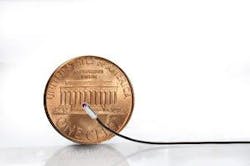Medigus Ltd.’s micro ScoutCam 1.2 camera, a CMOS-based camera that is only 1.2 mm in outer diameter, will be incorporated in NASA’s Visual Inspection Poseable Invertebrate Robot (VIPIR) tool, which will be used as part of the Robotic Refueling Mission on the International Space Station (ISS).
The Robotic Refueling Mission is an experiment on the ISS that involves the demonstration of tools, technologies, and techniques for on-orbit satellite servicing since 2011. The ScoutCam will be integrated as the borescope camera on VIPIR, which is designed to provide visual inspection capabilities in space. ScoutCam features a CMOS image sensor with a 2.2 µm x 2.2 µm pixel size and an image area of 492.8 µm x 488.4 µm. The camera, which is only 5 mm in total length, achieves a frame rate of 30 fps and is able with a 100° or 130° field of view.
The ScoutCam 1.2 was launched to the ISS at the end of July as part of the second phase of NASA’s Robotic Refueling Mission, with Phase 1 having been completed in May 2013.
"NASA is steadily maturing a set of robotic technologies that could help prolong the lives of satellites on orbit, thereby providing new capabilities for the Agency," said Benjamin Reed, deputy project manager of NASA's Satellite Servicing Capabilities Office in a press release. "Medigus' micro ScoutCam™ 1.2 met the requirements for VIPIR's borescope camera, and will demonstrate inspection capabilities once Robotic Refueling Mission operations begin."
Medigus touts the ScoutCam 1.2 as the smallest camera in the world, which enables it for use in a number of medical applications, including gastroenterology, cardiology, urology, gynecology, and dentistry, as well as industrial applications such as robotics and non-destructive testing.
View more information on the ScoutCam 1.2.
Also check out:
NASA engineer developing 3D printed space cameras
NASA ’s Mars Curiosity rover celebrates Martian Year anniversary with a selfie
NASA to use Google’s 3D Project Tango devices in space station robots
Share your vision-related news by contacting James Carroll, Senior Web Editor, Vision Systems Design
To receive news like this in your inbox, click here.
Join our LinkedIn group | Like us on Facebook | Follow us on Twitter | Check us out on Google +






